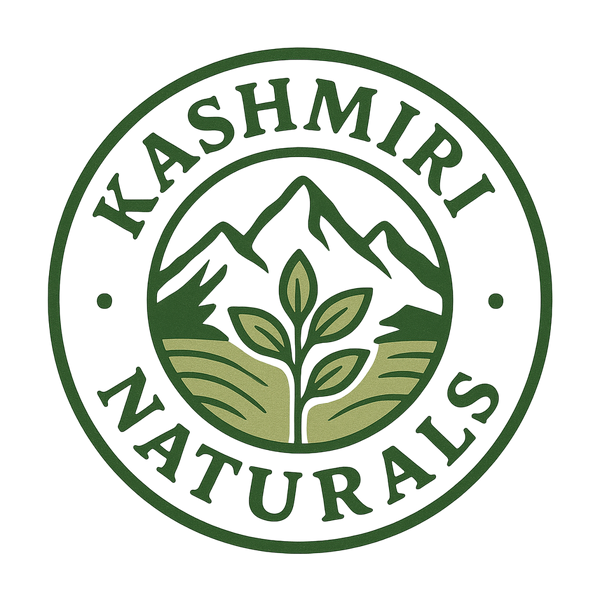
The Golden Spice of Kashmir: A Complete Guide to Saffron
Sep 05, 2025 | Raghu B
Saffron, often called the “golden spice,” is one of the most treasured and luxurious ingredients in the world. Derived from the delicate stigmas of the Crocus sativus flower, saffron has been cultivated for centuries in Kashmir, Iran, Greece, and Spain. Its deep crimson threads are not only prized for their exotic flavor and aroma but also for their remarkable health benefits. Today, saffron continues to symbolize purity, wellness, and indulgence, making it a staple in kitchens, medicines, and beauty rituals around the globe.
A Brief History of Saffron
Saffron has a rich history dating back over 3,000 years. Ancient civilizations used it for cooking, dyeing fabrics, and even in sacred rituals. In Kashmir, saffron farming has been a tradition passed down through generations. The Pampore region, often referred to as the “Saffron Town of India,” is particularly renowned for producing some of the highest-quality saffron in the world. Its unique climate and soil conditions give Kashmiri saffron a richer aroma, deeper color, and stronger flavor compared to other varieties.

The Cultivation Process: Why Saffron Is So Expensive
Saffron’s high price tag—often exceeding $5,000 per pound—stems from its labor-intensive cultivation. Each Crocus sativus flower produces only three stigmas, which must be hand-picked at dawn before the petals wilt. It takes around 150,000 flowers (and countless hours of labor) to produce just one kilogram of saffron.
The flowers bloom for only a few weeks each year, typically in autumn, in regions like Iran, Spain, India (Kashmir), and Greece. Iran leads global production, accounting for over 90% of the world’s supply. After harvesting, the stigmas are carefully dried to preserve their flavor and aroma, a process that requires precision to maintain quality.
Health Benefits of Saffron
-
Rich in Antioxidants
Saffron contains compounds like crocin, crocetin, and safranal that help fight free radicals and protect the body from oxidative stress.
2. Boosts Mood and Mental Health
Often referred to as the “sunshine spice,” saffron has been shown to improve mood, reduce symptoms of depression, and relieve anxiety.
3. Supports Eye Health
Studies suggest saffron may improve vision in adults with age-related macular degeneration and protect against retinal damage.
4. Enhances Skin Glow
Traditionally, saffron has been used in face packs and beauty treatments for its ability to brighten the complexion and promote radiant skin.
5. Improves Digestion and Immunity
Saffron’s natural compounds aid in digestion and strengthen the immune system, making it a valued ingredient in traditional medicine.
Culinary Uses of Saffron
Saffron’s unique taste—a mix of floral, earthy, and slightly sweet—makes it a luxurious addition to both sweet and savory dishes.
Beverages: Infused in warm milk, saffron creates the famous “Kesar Doodh,” known for its soothing and health-enhancing qualities.
Rice Dishes: Saffron rice, biryani, and paella are incomplete without their golden hue and distinct aroma.
Desserts: From kheer and kulfi to cakes and pastries, saffron adds richness and flavor to sweet treats.
Teas & Herbal Blends: Saffron tea is popular for its calming and refreshing properties.
Tips for Buying and Storing Saffron
To ensure you’re getting high-quality saffron:
Look for Vibrant Color: Premium saffron has a deep red color with minimal yellow or white threads.
Check the Aroma: Authentic saffron has a strong, floral scent. If it smells musty or weak, it may be old or adulterated.
Buy from Reputable Sources: Avoid overly cheap saffron, as it may be mixed with fillers like safflower or turmeric.
Store saffron in an airtight container in a cool, dark place to preserve its potency for up to two years.
Why Kashmiri Saffron Stands Out
Kashmiri saffron is often considered the world’s finest due to its:
- Deep Red Stigmas: Indicating higher crocin content (responsible for rich color).
- Powerful Aroma: Stronger than many other saffron varieties.
- Limited Production: Cultivated in small regions, making it rare and exclusive.
When buying saffron, always look for authenticity markers such as GI tags (Geographical Indication), which confirm genuine Kashmiri saffron.
Why Choose Kashmiri Naturals?
At Kashmiri Naturals, we’re passionate about bringing the essence of Kashmir to your home. Our saffron is carefully handpicked, rigorously tested, and packaged to preserve its quality. When you choose our saffron, you’re not just buying a spice—you’re embracing a legacy of tradition, quality, and authenticity.
Explore our range of saffron products on Kashmir Naturals and elevate your culinary and wellness experiences. From cooking to self-care, let the golden spice of Kashmir transform your everyday moments into something extraordinary.
Conclusion
Saffron is more than just a spice—it’s a symbol of luxury, health, and tradition. Whether you are using it to enrich your meals, enhance your wellness, or brighten your skin, saffron truly lives up to its reputation as the “golden spice.” With its unmatched quality, Kashmiri saffron continues to reign supreme, bringing the heritage of the valley to homes and hearts worldwide.




